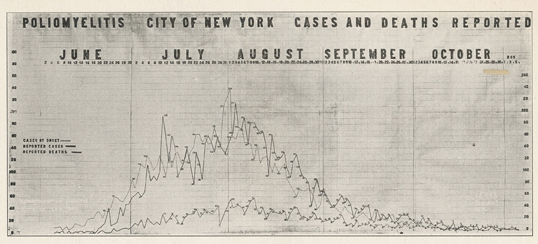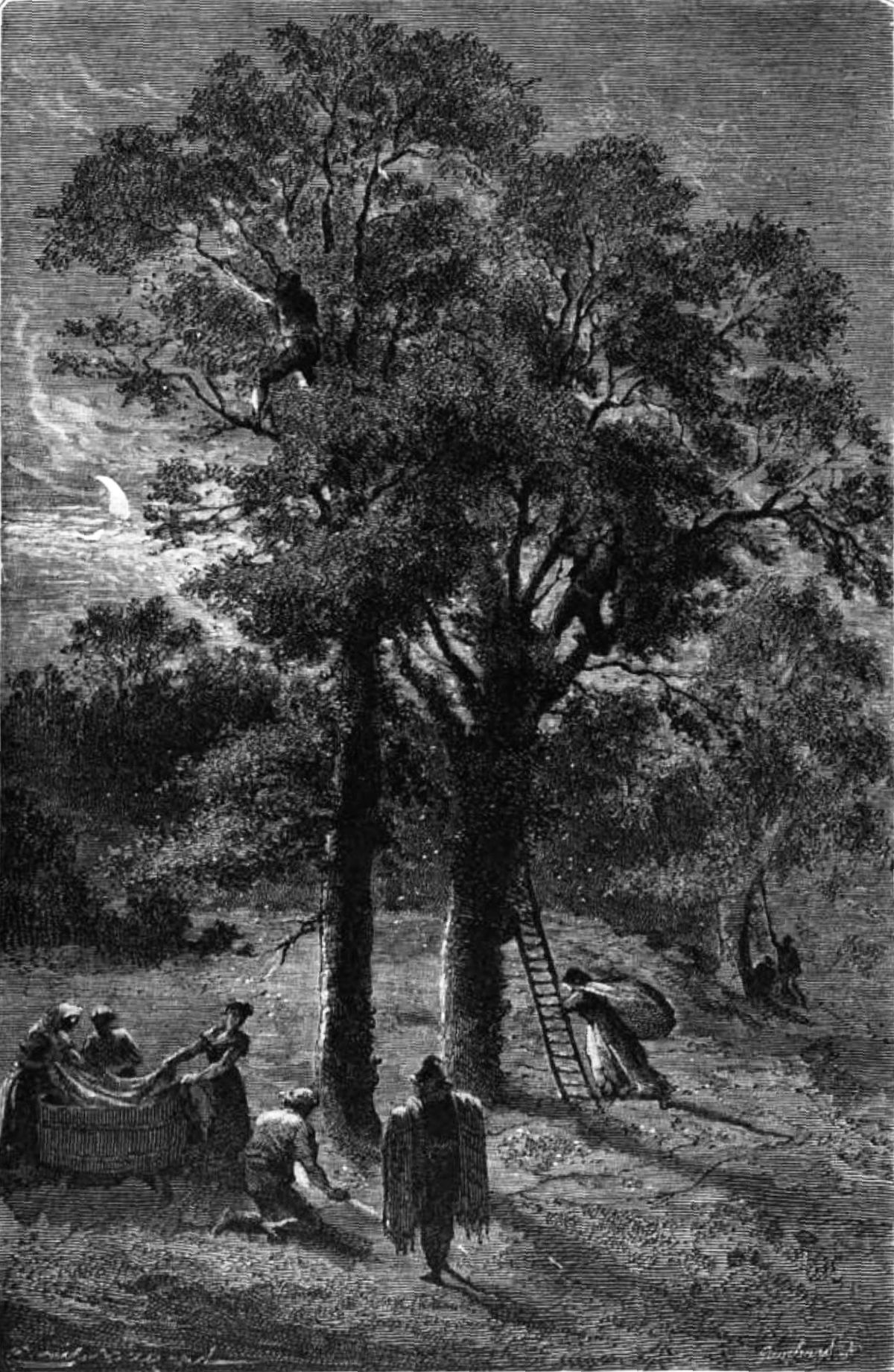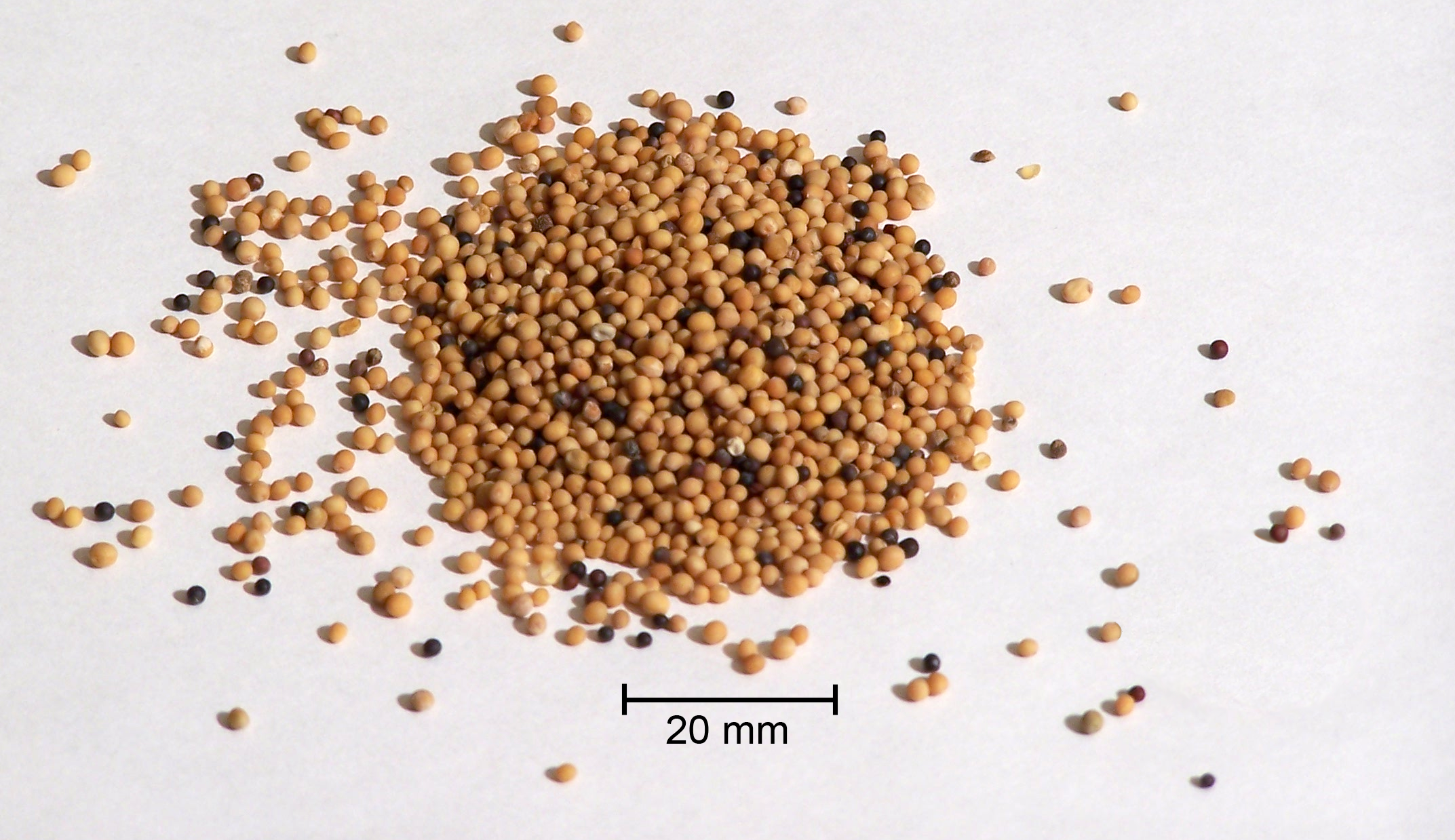|
1916 New York City Polio Epidemic
The 1916 New York City polio epidemic was an infectious disease epidemic of polio ultimately infecting several thousand people, and killing over two thousand, in New York City, primarily in the borough of Brooklyn. The epidemic was officially announced in June 1916, and a special field force was assembled under the authority of Dr. Simon R. Blatteis of the New York City Health Department's Bureau of Preventable Diseases, with broad authority to quarantine those infected with polio and institute hygiene measures thought to slow the transmission of the disease. Polio was a poorly understood disease in this era, and no polio vaccine existed at this time. Official efforts to stem its spread consisted primarily of quarantines, the closure of public places, and the use of chemical disinfectants to cleanse areas where the disease had been present. Special polio clinics were established at various locations in the city for the treatment and quarantine of patients. In addition, many info ... [...More Info...] [...Related Items...] OR: [Wikipedia] [Google] [Baidu] |
Polio
Poliomyelitis ( ), commonly shortened to polio, is an infectious disease caused by the poliovirus. Approximately 75% of cases are asymptomatic; mild symptoms which can occur include sore throat and fever; in a proportion of cases more severe symptoms develop such as headache, neck stiffness, and paresthesia. These symptoms usually pass within one or two weeks. A less common symptom is permanent Flaccid paralysis, paralysis, and possible death in extreme cases.. Years after recovery, post-polio syndrome may occur, with a slow development of muscle weakness similar to what the person had during the initial infection. Polio occurs naturally only in humans. It is highly infectious, and is spread from person to person either through fecal–oral route, fecal–oral transmission (e.g. poor hygiene, or by ingestion of food or water contaminated by human feces), or via the oral–oral route. Those who are infected may spread the disease for up to six weeks even if no symptoms are pre ... [...More Info...] [...Related Items...] OR: [Wikipedia] [Google] [Baidu] |
Social Distancing
In public health, social distancing, also called physical distancing, (NB. Regula Venske is president of the PEN Centre Germany.) is a set of non-pharmaceutical interventions or measures intended to prevent the spread of a contagious disease by maintaining a physical distance between people and reducing the number of times people come into close contact with each other. It usually involves keeping a certain distance from others (the distance specified differs from country to country and can change with time) and avoiding gathering together in larger groups. By minimising the probability that a given uninfected person will come into physical contact with an infected person, the disease transmission can be suppressed, resulting in fewer deaths. The measures may be used in combination with other public health recommendations, such as good respiratory hygiene, use of face masks when necessary, and hand washing. To slow down the spread of infectious diseases and avoid overb ... [...More Info...] [...Related Items...] OR: [Wikipedia] [Google] [Baidu] |
Lytta Vesicatoria
''Lytta vesicatoria'', also known as the Spanish fly, is an aposematic emerald-green beetle in the blister beetle family (Meloidae). It is distributed across Eurasia. The species and others in its family were used in traditional apothecary preparations as "Cantharides". The insect is the source of the terpenoid cantharidin, a toxic blistering agent once used as an exfoliating agent, anti-rheumatic drug and an aphrodisiac. The substance has also found culinary use in some blends of the North African spice mix '' ras el hanout''. Its various supposed benefits have been responsible for accidental poisonings. Etymology and taxonomy The generic name is from the Greek λύττα (''lytta''), meaning martial rage, raging madness, Bacchic frenzy, or rabies. The specific name is derived from Latin ''vesica'', blister. ''Lytta vesicatoria'' was formerly named ''Cantharis vesicatoria'', although the genus '' Cantharis'' is in an unrelated family, Cantharidae, the soldier beetles. ... [...More Info...] [...Related Items...] OR: [Wikipedia] [Google] [Baidu] |
Mustard Seed
Mustard seeds are the small round seeds of various mustard plants. The seeds are usually about in diameter and may be colored from yellowish white to black. They are an important spice in many regional foods and may come from one of three different plants: black mustard ('' Brassica nigra''), brown mustard ('' B. juncea''), or white mustard ('' Sinapis alba''). Grinding and mixing the seeds with water, vinegar or other liquids creates the yellow condiment known as mustard. Cultivation Mustard seeds generally take eight to ten days to germinate if placed under the proper conditions, which include a cold atmosphere and relatively moist soil. Mature mustard plants grow into shrubs. Yellow mustard has a plant maturity of 85 to 90 days; whereas, brown and oriental mustard have a plant maturity of 90 to 95 days. If the temperature conditions are conducive to growth, a mustard plant will begin to bud five weeks after the seedlings have appeared. The plant will reach full bloo ... [...More Info...] [...Related Items...] OR: [Wikipedia] [Google] [Baidu] |
Arnica
''Arnica'' is a genus of perennial plant, perennial, herbaceous plants in the sunflower family (Asteraceae). The genus name ''Arnica'' may be derived from the Greek language, Greek ''wikt:arni, arni'', "lamb", in reference to the plants' soft, hairy leaves. ''Arnica'' is also known by the names ''mountain tobacco'' and, confusingly, ''leopard's bane'' and ''wolfsbane''—two names that it shares with the entirely unrelated genus ''Aconitum''. This Circumboreal Region, circumboreal and montane (subalpine) genus occurs mostly in the temperate regions of western North America, with a few species native to the Arctic Circle, Arctic regions of northern Eurasia and North America. ''Arnica'' species are used as food plants by the larvae of some Lepidoptera species, including ''Bucculatricidae, Bucculatrix arnicella''. ''Arnica'' was previously classified in the tribe Senecioneae because it has a flower or pappus (flower structure), pappus of fine bristles. Characteristics ''Arnica'' ... [...More Info...] [...Related Items...] OR: [Wikipedia] [Google] [Baidu] |
Slippery Elm
''Ulmus rubra'', the slippery elm, is a species of elm native to eastern North America. Other common names include red elm, gray elm, soft elm, moose elm, and Indian elm. Description ''Ulmus rubra'' is a medium-sized deciduous tree with a spreading head of branches,Hillier & Sons. (1990). ''Hillier's Manual of Trees & Shrubs, 5th ed.''. David & Charles, Newton Abbot, UK commonly growing to , very occasionally over in height. Its heartwood is reddish-brown. The broad oblong to obovate leaves are long, rough above but velvety below, with coarse double-serrate margins, acuminate apices and oblique bases; the petioles are long.Bean, W. J. (1970). ''Trees & Shrubs Hardy in the British Isles'', 8th ed., p. 656. (2nd impression 1976) John Murray, London. The leaves are often tinged red on emergence, turning dark green by summer and a dull yellow in autumn. The perfect, apetalous, wind-pollinated flowers are produced before the leaves in early spring, usually in tight, short- ... [...More Info...] [...Related Items...] OR: [Wikipedia] [Google] [Baidu] |
Roman Chamomile
''Chamaemelum nobile'', commonly known as chamomile (also spelled camomile), is a low perennial plant found in dry fields and around gardens and cultivated grounds in Europe, North America, and South America. Its synonym is ''Anthemis nobilis'', with various common names, such as Roman chamomile, English chamomile, garden chamomile, ground apple, low chamomile, mother's daisy or whig plant.T. K. Lim ''C. nobile'' is one source of the herbal product known as chamomile using dried flowers for flavoring teas or as a fragrance used in aromatherapy. Chamomile has no established medicinal properties. Description ''Chamaemelum nobile'' has daisy-like white flowers and procumbent stems; the leaves are alternate, bipinnate, finely dissected, and downy to glabrous. The solitary, terminal flowerheads, rising above the ground, consist of prominent yellow disk flowers and silver-white ray flowers. The flowering time in the Northern Hemisphere is June and July, and its fragrance is ... [...More Info...] [...Related Items...] OR: [Wikipedia] [Google] [Baidu] |
Poultice
A poultice or cataplasm, also called a fomentation, is a soft moist mass, often heated and medicated, that is applied to the skin to reduce inflammation, soothe pain, promote healing, or otherwise treat wounds or ailments. Soft materials like cereals are used as a base, to which agents intended to affect the body, transdermally, may be added. The preparation is usually spread on cloth, which is then applied to the body part to be treated. The cloth is used to keep the preparation in place, or additional bandaging to hold the poultice may be employed. Direct topical application (without cloths) is also used. Poultice may also refer to a porous solid, filled with a solvent used to remove stains from porous stone such as marble or granite. The word ''poultice'' comes from the Greek word transformed to the , , ' porridge'. History Asia North America * Native Americans have thousands of plants for the making of poultices. Preparation and composition * Some Native America ... [...More Info...] [...Related Items...] OR: [Wikipedia] [Google] [Baidu] |
Oxidise
Redox ( , , reduction–oxidation or oxidation–reduction) is a type of chemical reaction in which the oxidation states of the reactants change. Oxidation is the loss of electrons or an increase in the oxidation state, while reduction is the gain of electrons or a decrease in the oxidation state. The oxidation and reduction processes occur simultaneously in the chemical reaction. There are two classes of redox reactions: * Electron-transfer – Only one (usually) electron flows from the atom, ion, or molecule being oxidized to the atom, ion, or molecule that is reduced. This type of redox reaction is often discussed in terms of redox couples and electrode potentials. * Atom transfer – An atom transfers from one substrate to another. For example, in the rusting of iron, the oxidation state of iron atoms increases as the iron converts to an oxide, and simultaneously, the oxidation state of oxygen decreases as it accepts electrons released by the iron. Although oxidati ... [...More Info...] [...Related Items...] OR: [Wikipedia] [Google] [Baidu] |
Almond Meal
Almond meal, almond flour or ground almond is made from ground sweet almonds. Almond flour is usually made with blanched almonds (no skin), whereas almond meal can be made with whole or blanched almonds. The consistency is more like corn meal than wheat flour. It is used in pastry and confectionery – in the manufacture of almond macarons and macaroons and other sweet pastries, in cake and pie filling, such as Austrian ''Sachertorte'' – and is one of the two main ingredients of marzipan and almond paste. In France, almond meal is an important ingredient in ''frangipane'', the filling of traditional ''galette des Rois'' cake. Almond meal has recently become important in baking items for those on low-carbohydrate diets. It adds moistness and a rich nutty taste to baked goods. Items baked with almond meal tend to be calorie-dense. Almonds have high levels of polyunsaturated fats. Typically, the omega 6 fatty acids in almonds are protected from oxidation by the surface skin an ... [...More Info...] [...Related Items...] OR: [Wikipedia] [Google] [Baidu] |
Electricity
Electricity is the set of physical phenomena associated with the presence and motion of matter possessing an electric charge. Electricity is related to magnetism, both being part of the phenomenon of electromagnetism, as described by Maxwell's equations. Common phenomena are related to electricity, including lightning, static electricity, electric heating, electric discharges and many others. The presence of either a positive or negative electric charge produces an electric field. The motion of electric charges is an electric current and produces a magnetic field. In most applications, Coulomb's law determines the force acting on an electric charge. Electric potential is the Work (physics), work done to move an electric charge from one point to another within an electric field, typically measured in volts. Electricity plays a central role in many modern technologies, serving in electric power where electric current is used to energise equipment, and in electronics dealing w ... [...More Info...] [...Related Items...] OR: [Wikipedia] [Google] [Baidu] |
Oxygen
Oxygen is a chemical element; it has chemical symbol, symbol O and atomic number 8. It is a member of the chalcogen group (periodic table), group in the periodic table, a highly reactivity (chemistry), reactive nonmetal (chemistry), nonmetal, and a potent oxidizing agent that readily forms oxides with most elements as well as with other chemical compound, compounds. Oxygen is abundance of elements in Earth's crust, the most abundant element in Earth's crust, making up almost half of the Earth's crust in the form of various oxides such as water, carbon dioxide, iron oxides and silicates.Atkins, P.; Jones, L.; Laverman, L. (2016).''Chemical Principles'', 7th edition. Freeman. It is abundance of chemical elements, the third-most abundant element in the universe after hydrogen and helium. At standard temperature and pressure, two oxygen atoms will chemical bond, bind covalent bond, covalently to form dioxygen, a colorless and odorless diatomic gas with the chemical formula ... [...More Info...] [...Related Items...] OR: [Wikipedia] [Google] [Baidu] |







